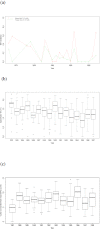Genetic parameters of infectious bovine keratoconjunctivitis and its relationship with weight and parasite infestations in Australian tropical Bos taurus cattle
- PMID: 22839739
- PMCID: PMC3517348
- DOI: 10.1186/1297-9686-44-22
Genetic parameters of infectious bovine keratoconjunctivitis and its relationship with weight and parasite infestations in Australian tropical Bos taurus cattle
Abstract
Background: Infectious bovine keratoconjunctivitis (IBK) or 'pinkeye' is an economically important ocular disease that significantly impacts animal performance. Genetic parameters for IBK infection and its genetic and phenotypic correlations with cattle tick counts, number of helminth (unspecified species) eggs per gram of faeces and growth traits in Australian tropically adapted Bos taurus cattle were estimated.
Methods: Animals were clinically examined for the presence of IBK infection before and after weaning when the calves were 3 to 6 months and 15 to 18 months old, respectively and were also recorded for tick counts, helminth eggs counts as an indicator of intestinal parasites and live weights at several ages including 18 months.
Results: Negative genetic correlations were estimated between IBK incidence and weight traits for animals in pre-weaning and post-weaning datasets. Genetic correlations among weight measurements were positive, with moderate to high values. Genetic correlations of IBK incidence with tick counts were positive for the pre-weaning and negative for the post-weaning datasets but negative with helminth eggs counts for the pre-weaning dataset and slightly positive for the post-weaning dataset. Genetic correlations between tick and helminth eggs counts were moderate and positive for both datasets. Phenotypic correlations of IBK incidence with helminth eggs per gram of faeces were moderate and positive for both datasets, but were close to zero for both datasets with tick counts.
Conclusions: Our results suggest that genetic selection against IBK incidence in tropical cattle is feasible and that calves genetically prone to acquire IBK infection could also be genetically prone to have a slower growth. The positive genetic correlations among weight traits and between tick and helminth eggs counts suggest that they are controlled by common genes (with pleiotropic effects). Genetic correlations between IBK incidence and tick and helminth egg counts were moderate and opposite between pre-weaning and post-weaning datasets, suggesting that the environmental and (or) maternal effects differ between these two growth phases. This preliminary study provides estimated genetic parameters for IBK incidence, which could be used to design selection and breeding programs for tropical adaptation in beef cattle.
Figures



Similar articles
-
Genetic and environmental factors associated with incidence of infectious bovine keratoconjunctivitis in preweaned beef calves.J Anim Sci. 2005 Mar;83(3):507-18. doi: 10.2527/2005.833507x. J Anim Sci. 2005. PMID: 15705746
-
Associations between infectious bovine keratoconjunctivitis at weaning and ultrasongraphically measured body composition traits in yearling cattle.J Am Vet Med Assoc. 2014 Jan 1;244(1):100-6. doi: 10.2460/javma.244.1.100. J Am Vet Med Assoc. 2014. PMID: 24344858
-
Bovine genetic resistance effects on biological traits of Rhipicephalus (Boophilus) microplus.Vet Parasitol. 2015 Mar 15;208(3-4):231-7. doi: 10.1016/j.vetpar.2015.01.010. Epub 2015 Jan 19. Vet Parasitol. 2015. PMID: 25648284
-
Non-antimicrobial approaches for the prevention or treatment of infectious bovine keratoconjunctivitis in cattle applicable to cow-calf operations: A scoping review.Animal. 2021 Jun;15(6):100245. doi: 10.1016/j.animal.2021.100245. Epub 2021 May 31. Animal. 2021. PMID: 34062463
-
A Review of Global Prevalence and Economic Impacts of Infectious Bovine Keratoconjunctivitis.Vet Clin North Am Food Anim Pract. 2021 Jul;37(2):355-369. doi: 10.1016/j.cvfa.2021.03.010. Vet Clin North Am Food Anim Pract. 2021. PMID: 34049665 Review.
Cited by
-
Genetic influence on the composition of the ocular microbiome in preweaned beef calves.J Anim Sci. 2025 Jan 4;103:skaf153. doi: 10.1093/jas/skaf153. J Anim Sci. 2025. PMID: 40319373
-
A comparison of nonlinear mixed models and response to selection of tick-infestation on lambs.PLoS One. 2017 Mar 3;12(3):e0172711. doi: 10.1371/journal.pone.0172711. eCollection 2017. PLoS One. 2017. PMID: 28257433 Free PMC article.
-
Bovine ocular microbiome: the next frontier in managing Pinkeye in cattle.Anim Microbiome. 2025 Jun 4;7(1):58. doi: 10.1186/s42523-025-00425-9. Anim Microbiome. 2025. PMID: 40468436 Free PMC article.
-
Evaluation of crossbreeding strategies for improved adaptation and productivity in African smallholder cattle farms.Genet Sel Evol. 2025 Feb 20;57(1):6. doi: 10.1186/s12711-025-00952-8. Genet Sel Evol. 2025. PMID: 39979829 Free PMC article.
-
A multiplex real-time PCR assay for the detection and differentiation of five bovine pinkeye pathogens.J Microbiol Methods. 2019 May;160:87-92. doi: 10.1016/j.mimet.2019.03.024. Epub 2019 Mar 29. J Microbiol Methods. 2019. PMID: 30930057 Free PMC article.
References
-
- Jonsson NN, Vankan D, Stear MJ, Waine D, Gray CP. Selecting cattle for host resistance to tick (Rhipicephalus microplus) infestation - natural and human-directed selection. Proceedings of the 31st International Conference on Animal Genetics: 20–24 July 2008; Amsterdam. 2008. poster 2171 http://www.isag.us/Docs/2008_ISAG_Amsterdam_P2000.pdf.
-
- Frisch JE. Changes occurring in cattle as a consequence of selection for growth-rate in a stressful environment. J Agr Sci. 1981;96:23–38. doi: 10.1017/S0021859600031841. - DOI
-
- Prayaga KC, Henshall JM. Adaptability in tropical beef cattle: genetic parameters of growth, adaptive and temperament traits in a crossbred population. Aust J Exp Agr. 2005;45:971–983. doi: 10.1071/EA05045. - DOI
Publication types
MeSH terms
LinkOut - more resources
Full Text Sources
Medical

